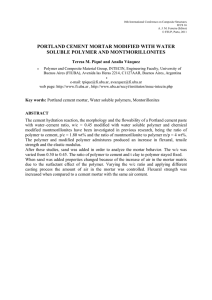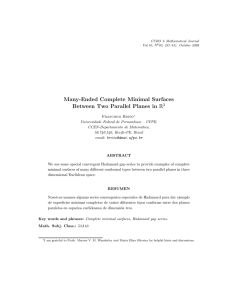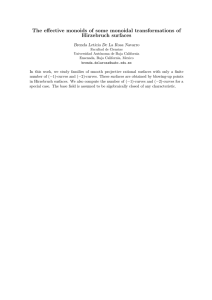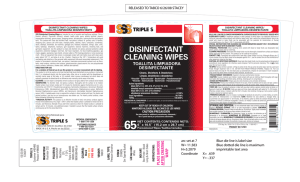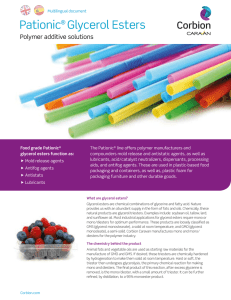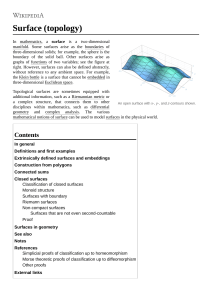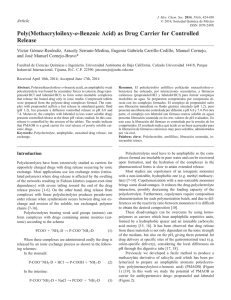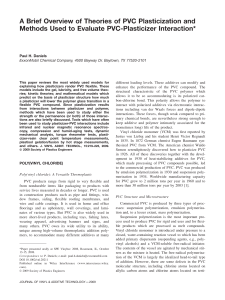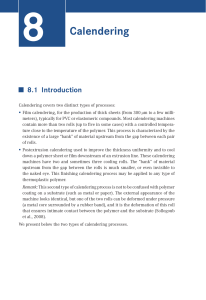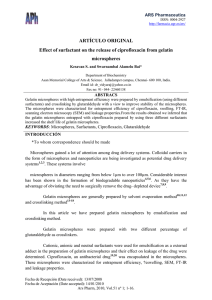Juan Rodríguez-Hernández CV ICTP
Anuncio
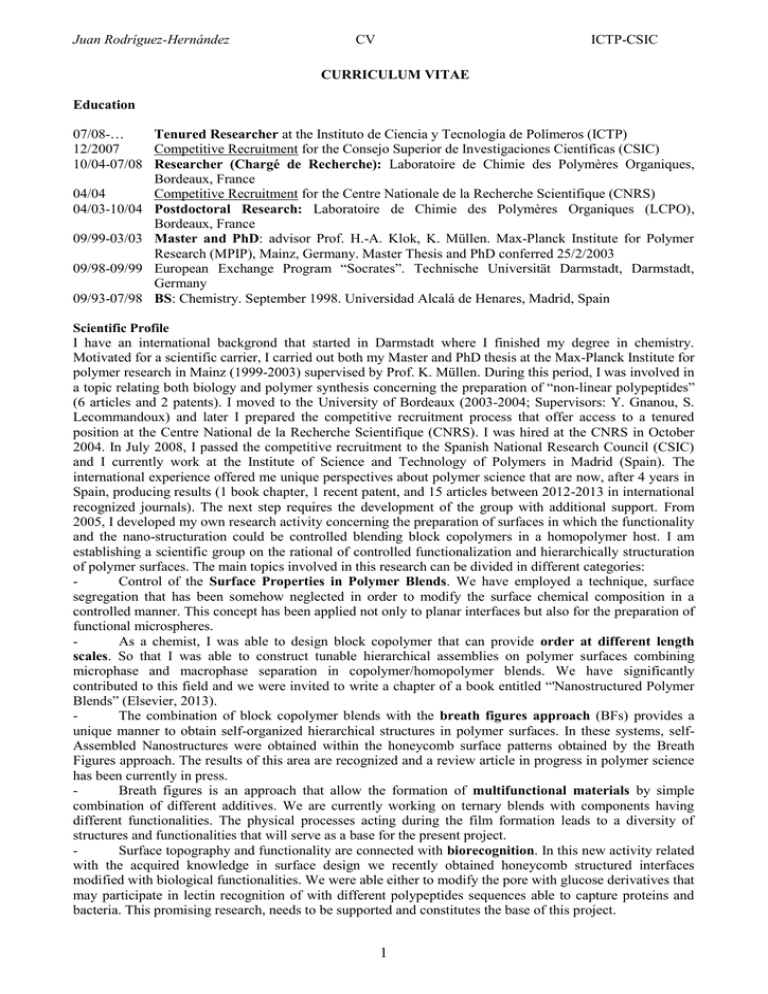
Juan Rodríguez-Hernández CV ICTP-CSIC CURRICULUM VITAE Education 07/08-… Tenured Researcher at the Instituto de Ciencia y Tecnología de Polímeros (ICTP) 12/2007 Competitive Recruitment for the Consejo Superior de Investigaciones Científicas (CSIC) 10/04-07/08 Researcher (Chargé de Recherche): Laboratoire de Chimie des Polymères Organiques, Bordeaux, France 04/04 Competitive Recruitment for the Centre Nationale de la Recherche Scientifique (CNRS) 04/03-10/04 Postdoctoral Research: Laboratoire de Chimie des Polymères Organiques (LCPO), Bordeaux, France 09/99-03/03 Master and PhD: advisor Prof. H.-A. Klok, K. Müllen. Max-Planck Institute for Polymer Research (MPIP), Mainz, Germany. Master Thesis and PhD conferred 25/2/2003 09/98-09/99 European Exchange Program “Socrates”. Technische Universität Darmstadt, Darmstadt, Germany 09/93-07/98 BS: Chemistry. September 1998. Universidad Alcalá de Henares, Madrid, Spain Scientific Profile I have an international backgrond that started in Darmstadt where I finished my degree in chemistry. Motivated for a scientific carrier, I carried out both my Master and PhD thesis at the Max-Planck Institute for polymer research in Mainz (1999-2003) supervised by Prof. K. Müllen. During this period, I was involved in a topic relating both biology and polymer synthesis concerning the preparation of “non-linear polypeptides” (6 articles and 2 patents). I moved to the University of Bordeaux (2003-2004; Supervisors: Y. Gnanou, S. Lecommandoux) and later I prepared the competitive recruitment process that offer access to a tenured position at the Centre National de la Recherche Scientifique (CNRS). I was hired at the CNRS in October 2004. In July 2008, I passed the competitive recruitment to the Spanish National Research Council (CSIC) and I currently work at the Institute of Science and Technology of Polymers in Madrid (Spain). The international experience offered me unique perspectives about polymer science that are now, after 4 years in Spain, producing results (1 book chapter, 1 recent patent, and 15 articles between 2012-2013 in international recognized journals). The next step requires the development of the group with additional support. From 2005, I developed my own research activity concerning the preparation of surfaces in which the functionality and the nano-structuration could be controlled blending block copolymers in a homopolymer host. I am establishing a scientific group on the rational of controlled functionalization and hierarchically structuration of polymer surfaces. The main topics involved in this research can be divided in different categories: Control of the Surface Properties in Polymer Blends. We have employed a technique, surface segregation that has been somehow neglected in order to modify the surface chemical composition in a controlled manner. This concept has been applied not only to planar interfaces but also for the preparation of functional microspheres. As a chemist, I was able to design block copolymer that can provide order at different length scales. So that I was able to construct tunable hierarchical assemblies on polymer surfaces combining microphase and macrophase separation in copolymer/homopolymer blends. We have significantly contributed to this field and we were invited to write a chapter of a book entitled “'Nanostructured Polymer Blends” (Elsevier, 2013). The combination of block copolymer blends with the breath figures approach (BFs) provides a unique manner to obtain self-organized hierarchical structures in polymer surfaces. In these systems, selfAssembled Nanostructures were obtained within the honeycomb surface patterns obtained by the Breath Figures approach. The results of this area are recognized and a review article in progress in polymer science has been currently in press. Breath figures is an approach that allow the formation of multifunctional materials by simple combination of different additives. We are currently working on ternary blends with components having different functionalities. The physical processes acting during the film formation leads to a diversity of structures and functionalities that will serve as a base for the present project. Surface topography and functionality are connected with biorecognition. In this new activity related with the acquired knowledge in surface design we recently obtained honeycomb structured interfaces modified with biological functionalities. We were able either to modify the pore with glucose derivatives that may participate in lectin recognition of with different polypeptides sequences able to capture proteins and bacteria. This promising research, needs to be supported and constitutes the base of this project. 1 Juan Rodríguez-Hernández CV ICTP-CSIC - Finally, more recently I´m exploring alternative (to BFs) approaches for surface structuring. Two PhD students are currently involved in the preparation of surface patterns by using stereolithography and by inducing surface wrinkles. These two new approaches combined with the know-how on phase separation of polymer blends are may offer novel alternatives for the creation of platforms with precise morphology and functionality. In particular the original approach developed to prepare surface wrinkles has been protected by a patent (2012) and international extension is under evaluation. PhD and MASTER students: I conducted 6 Post-docts and 1PhD student (already finished in Bordeaux 2008) and I´m currently involved in the direction/codirection of 3 PhD Thesis. In addition I participated in the formation of 8 Master students. INVITED SEMINARS/TALKS/CONFERENCES - The PI assisted to 56 conferences (national and international) giving 40 oral prensentations. Selected Invited seminars/conferences/courses (of a total of 10): - “Surface Engineering using block copolymers”. Invited seminar. Universität Basel, July 2006 - “Control of the surfaces properties in polymer blends”. 2nd workshop Biopolysurf (Marie Curie Training Network). Murten/Muntelier – (Switzerland) April 2006 - Introductory course to the “Synthesis, properties and applications of polypeptides”. Technological University of Catalonia. Barcelone. July 2006. - “Preparation of functional surfaces by surface segregation of diblock copolymers” Invited seminar. University of the Basque Country, January 2012 CURRENT SCIENTIFIC COLLABORATIONS The activities developed in my group have been carried out in a collaborative framework with different national and international institutions. Some groups with which we are currently cooperatimg are: - "Nanostructured Polymer films". Prof. Günter Reiter (Freiburg Univ.) - “Boundary Lubricant Films under shear: effect of roughness and adhesion” Dr. C. Drummond, Prof. P. Richetti (CRPP) - “Multilayer thin films from functional polymer surfaces” Dr. P. Schaaf (ICS-Strasbourg) - Surface characterization and survey of the functionalization processes. Dr. C. Labrugère (ICMCB) - Elaboration of polymeric surfaces for biorecognition purposes. Dr. Aitziber Lopez (IMDEA-Nanoscience) TEACHING ACTIVITIES: Germany: Chemie für Biologen. Johannes Gutenberg Universität (Mainz-Germany) (2004) France: Master Programme in Polymer Science. Ecole Nationale Superieure de Chimie et Physique de Bordeaux. Courses on: Polymer Brushes, Biocompatible Surfaces, BioAdhesives (2005-2006) (France) - Course on Polymer Characterization Université Bordeaux I (2006-2007) (France) - Course on Polymer Characerization (Spectroscopic methods) Ecole Nationale Superieure de Chimie et Physique de Bordeaux (2006-2007) (France) Spain: Master programme in Materials Science. Course on Design, preparation and applications of intelligent polymer surfaces. University Basque Country (2010-…) and Master in Polymer Science and Technology CSIC (2009-…). Courses on: Polymer Nanostructuration and Synthesis by CRP techniques (Spain). REVIEWER Acted as referee for numerous papers (Macromolecules, Langmuir, J Polym Sci Part A, Chem. Commun, ...) and of acted as referee for national and international grant proposals, (ANR-France, FONCYT-Argentine). Acted as referee for Ph.D. theses. FUNDING ID I have been involved in 16 different research projects. The research developed concerning polymer surfaces has been supported both by the French National Science Foundation by means of a Young Researcher Project (“Projet Jeunes Chercheurs”) has been granted in 2007 and the Spanish Science Foundation with four projects (200860I037, CCG08-CSIC/MAT-3643, MAT2009-12251, MAT2010-17016). Moreover, the research activity developed by the PI was selected recently within the framework of Excellence QualityRecherche (‘Bonus Qualité Recherche’) and a PhD thesis has been financed between the PI and the Centre de Recherche Paul Pascal (Bordeaux) to further investigate within the area of surface functionalization and nanostructuration on polymer surfaces. In addition, the I have experience in European projects (ECODISM European Union (FP6) STRP 516133) Early achievements track-record 2 Juan Rodríguez-Hernández CV ICTP-CSIC 1) Publications as main author The PI of this project is author of 56 research articles (50 without my PhD supervisor as co-author), 36 as main author. In addition I have been involved in 3 patents, one in exploitation and one recently achieved. In addition, he is author of 10 book chapters and has edited two books. Below I present a selected overview of the most significant publications concerning previous achievements that somehow related with the present project. 1) J. Rodríguez-Hernández, M. Gatti, H.-A. Klok. ”Highly-branched water-soluble poly(L-lysine)” Biomacromolecules 2003, 4, 249-258. 2) H.-A. Klok, J. Rodríguez-Hernández. “Dendritic-Graft Polypeptides”. Macromolecules, 2002, 35, 87188723. 3) J. Babin, J. Rodríguez-Hernández, S. Lecommandoux, H.-A. Klok, M.F. Achard “Self-Assembled nanostructures from peptide-synthetic hybrid block copolymers: complex, stimuli-responsive rod-coil architectures” Faraday Discussions 2004, 128, 179-192. (C:49) 4) J. Rodríguez-Hernández, F. Chécot, Y. Gnanou, S. Lecommandoux “Self-assembly of block copolymers in solution: towards smart nano-objects” Prog. Polym. Sci. 2005, 30, 691-724. 5) J. Rodríguez-Hernández, et al.“Reversible Inside-Out Micellization of pH-responsive and water-soluble vesicles based on polypeptide diblock copolymers” J. Am. Chem. Soc. 2005, 127, 2026-2027. 6) S. Lecommandoux, O. Sandre, F. Chécot, J. Rodríguez-Hernández, R. Perzynski “Magnetic nanocomposite Micelles and Vesicles” Adv. Mater. 2005, 17(6), 712-718. 7) J. Rodríguez-Hernández, J. Babin, B. Zappone, S. Lecommandoux “Preparation of Shell Cross-linked Nano-Objects from Hybrid-Peptide Block Copolymers” Biomacromolecules 2005, 6, 2213-2220. 8) E. Ibarboure, J. Rodríguez-Hernández, E. Papon “Thermotropic liquid cristal behavior on PBLG-PDMSPBLG triblock copolymers” J. Polym. Sci. Part A.: Polym. Chem. 2006, 44, 4668-4679. 9) A. Bousquet, E. Ibarboure, C. Labrugere, E. Papon, J. Rodríguez-Hernández “Magnetic-Field-Induced Assemblies of Ferromagnetic Particles: Covalent Immobilization on Functionalized Polymer Surfaces” Langmuir, 2007, 23, 6879-6882. 10) A. Bousquet, R. Perrier-Cornet, E. Ibarboure, E. Papon, C. Labrugère, V. Héroguez, J. RodríguezHernández “Functional pH-responsive polystyrene microspheres prepared by surface segregation of diblock copolymers” Macromolecules, 2007, 40,9549-9554. 11) A. Bousquet, E. Ibarboure, C. Drummond, C. Labrugère, E. Papon, J. Rodríguez-Hernández “Design of stimuli-responsive surfaces prepared by surface segregation of polypeptide-b-polystyrene diblockcopolymers” Macromolecules, 2008, 41, 1053-1056. 12) A. Bousquet, R. Perrier-Cornet, E. Ibarboure, E. Papon, C. Labrugère, V. Héroguez, J. RodríguezHernández “Design of Peptide Functionalized Polystyrene Microspheres” Biomacromolecules, 2008, 9, 1811-1817. 13) E. Ibarboure, A. Bousquet, G. Toquer, E. Papon, J. Rodríguez-Hernández “Tunable Hierarchical Assembly on Polymer Surfaces: combining micro and macrophase separation in copolymer/homopolymer blends” Langmuir, 2008, 24(13), 6391-6394. 14) A. Muñoz-Bonilla, E. Ibarboure, E. Papon, J. Rodríguez-Hernández “Towards stimuli-responsive polymer surfaces with variable chemistry and topography” J. Polym. Sci. Part A Polym. Chem. 2009, 47(9), 2262-2271. 15) A. Muñoz-Bonilla, E. Ibarboure, E. Papon, J. Rodríguez-Hernández “Self-Organized Hierarchical Structures In Polymer Surfaces: Self-Assembled Nanostructures Within Breath Figures” Langmuir 2009, 25(11), 6493-6499. 16) J. Poly, E. Ibarboure, J. Rodriguez-Hernandez, D. Taton, E. Papon “Reinforcing the Hydrophobicity of Polymeric Surfaces from Fluorinated Star Polymers and Nanogels” Macromolecules 2010, 43 (3), 1299– 1308. 17) A. Muñoz-Bonilla, E. Ibarboure, V. Bordegé, M. Fernández-García, J. Rodríguez-Hernández ”Fabrication of honeycomb structured porous surfaces decorated with glycopolymers” Langmuir 2010, 26(11), 8552-8558. 18) A. Bousquet, E. Ibarboure, E. Papon, C. Labrugère, J. Rodríguez-Hernández “Structured Multi StimuliResponsive Functional Polymer Surfaces obtained by Interfacial Diffusion of Amphiphilic Block Copolymers” J. Polym. Sci. Part A Polym. Chem. 2010, 48(9), 1952-1961. 19) E. Ibarboure, J. Rodríguez-Hernández ”Supramolecular structures from self-assembled poly(-benzyl L glutamate)-polydimethylsiloxane-poly(-benzyl-L glutamate) triblock copolypeptides in thin films” Eur. Polym. J. 2010, 46, 891-899. 3 Juan Rodríguez-Hernández CV ICTP-CSIC 20) A. Bousquet, E. Ibarboure, F.J. Teran, L. Ruiz, M.T. Garay, J.M. Laza, J.L. Vilas, E. Papon, J. Rodríguez-Hernández “pH Responsive Surfaces with Nanoscale Topography” J. Polym. Sci. Part A Polym. Chem. 2010, 48, 2982-2990. 21) A. Bousquet, E. Ibarboure, V. Héroguez, E. Papon, C. Labrugere, J. Rodríguez-Hernández “Single-Step Process to Produce Functionalized Multiresponsive Polymeric Particles” J. Polym. Sci. Part A Polym. Chem. 2010, 48 (16), 3523–3533. 22) A. Muñoz-Bonilla, A. Bousquet, E. Ibarboure, E. Papon, C. Labrugere, J. Rodríguez-Hernández “ Fabrication and Superhydrophobic Behavior of Fluorinated Microspheres” Langmuir, 2010, 26(22), 16775-16781. 23) J. Rodríguez-Hernández, A. Muñoz-Bonilla, A. Bousquet, E. Ibarboure, E. Papon “Environmentally responsive particles: from superhydrophobic particle films to water dispersible microspheres” Langmuir, 2010, 26(24), 18617-18620. 24) Julien Poly, Emmanuel Ibarboure, Jean-Francois Le Meins, Juan Rodríguez-Hernández, Daniel Taton, Eric Papon “Nanogels Based on Poly(vinyl acetate) for the Preparation of Patterned Porous Films” Langmuir 2011, 27, 4290–4295. 25) Alberto S. de Leon, Alexandra Muñoz-Bonilla, Marta Fernández-García, Juan Rodríguez-Hernández “Breath Figures Method to Control the Topography and the Functionality of Polymeric Surfaces in Porous Films and Microspheres” J. Polym. Sci. Part A Polym. Chem. 2012, 50, 851-859. 26) Alberto S. de León, Adolfo del Campo, Marta Fernández-García, Juan Rodríguez-Hernández, Alexandra Muñoz-Bonilla “Hierarchically Structured Multifunctional Porous Interfaces Through Water Templated Self-Assembly of Ternary Systems” Langmuir 2012, 28, 9778-9787. 27) Marta Palacios-Cuesta, Marta Liras, Christine Labrugère, Juan Rodríguez-Hernández and Olga García. “Functional micropatterned surfaces prepared by simultaneous UV-lithography and surface segregation of fluorinated copolymers”. J. Polym Science. Part A Polym. Chem. 2012, 50, 4902-4910. 28) M. Álvarez-Paino, A. Muñoz-Bonilla, J. Rodríguez-Hernández, M. Fernández-García “Synthesis and Lectin Recognition Studies of Glycosylated Polystyrene Microspheres Functionalized via Thiol-para Fluorine “Click” Reaction”. Polym. Chem. 2012, 3 (12), 3282-3288. 29) G. Marcelo, A. Muñoz-Bonilla, J. Rodríguez-Hernández, M. Fernández-García. “Hybrid nanobiomaterials achieved by polypeptide grafted magnetite nanoparticles through dopamine biomimetic surface anchored initiator” Polym Chem. 2013, 4, 558-567. 30) Alberto S. de León, Juan Rodríguez-Hernández, Aitziber L. Cortajarena. “Honeycomb patterned surfaces functionalized with polypeptide sequences for recognition and selective bacterial adhesion”. Biomaterials 2013, 34(5), 1453-1460. 31) Alexandra Muñoz-Bonilla, Marta Fernández-García and Juan Rodríguez-Hernández “Towards hierarchically ordered functional porous polymeric surfaces prepared by the Breath Figures approach”. Progress in Polymer 2014, 39(3), 510-554. 2) Research monographs, chapters in collective volumes and any translations thereof. - J. Rodríguez-Hernández, E. Papon “Aplicaciones poliméricas: Adhesivos Sensibles a la Presion (ASP)” Rev. Plast. Moder. 2005, 589, 46-53. - J. Rodríguez-Hernández “Nano/Micro and Hierarchical structured surfaces in polymer blends” Book Title: Nanostructures Polymer Blends. Editors: S. Thomas, C. Sarathchandran, R. Shanks. Elsevier Inc, USA. In press 2013. 3) Granted patent(s) - J. Rodríguez Hernández, S. Becker, H.-A. Klok, F. Schuh, K. Müllen. ”Funktionalisierte Perylentetracarbonsäurediimide” Patent DE 10037707.4 2000. Rights in exploitation by BASF AG (Ludwigshafen-Germany). - J. Rodríguez Hernández, H.-A. Klok, K. Müllen. “Method for the preparation of highly branched polypeptides” Europäische Patentanmeldung Nr. 02002204.2 2002. - M. Palacios-Cuesta, O. García, J. Rodríguez-Hernández “Procedure to obtain polymeric materials with structured interfaces and the potential applications” Nr. P201231928. 2012. . 4
